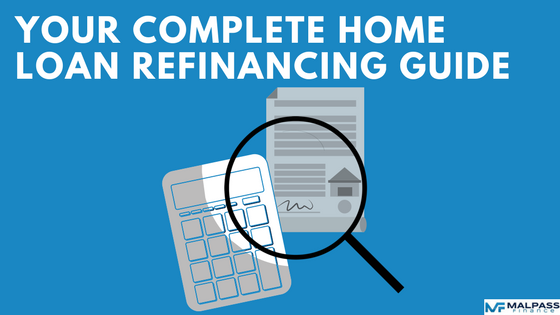Your Complete Guide to Refinancing your Home Loan
This guide to refinancing outlines the steps to ensure you aren't paying too much for your mortgage.
So you've noticed that your interest rate is not as good as it could be. Or your situation at home has changed; perhaps you're expecting a baby, or you've changed careers, and you're earning a different amount than you used to.
It's a good time to think about refinancing your home loan.
Refinancing is the process of checking your home loan is still the right one for your needs when your personal or economic circumstances change, or you need or want to review your current home loan to make sure it's still a good deal.
You can refinance with your current lender or through a new lender offering a loan that may have a more competitive interest rate, fewer or cheaper fees, or it simply has the features you are looking for in a home loan.
Any time you have a change in circumstances or notice better rates on offer is an excellent time to see whether you can save some money on your repayments, get a home loan better suited to your new situation or access some money to achieve some of your other goals. You might want to renovate, extend or redecorate.
Let me show you how easy it can be to make sure that your home loan fits you best as you change and grow. Here is my simple and straightforward guide to refinancing. It is a process best done with the assistance of a finance broker to do the checks and balances, who has done the research to refer to and the insider financial system experience to make great things happen for you.
This comprehensive list covers the things you need to know that will make the refinancing process quick and simple, and save money on your loan, and help you to own your home sooner. The guide is designed to help you work in well with your broker so that they have everything they need to help select the right loan products to help you achieve your financial goals. I believe that the best results happen when working with a mortgage broker.
So here it is, my simple step-by-step guide to refinancing:
 Step 1: Get Organised:
Step 1: Get Organised:
Being organised is key, so let's start by gathering all your relevant documents and information together so that you know where you stand financially right now.
Documents and information you will need to have at the ready:
- Six months of your home loan history - like statements from your current lender
- Your latest credit card statements for all your credit cards
- Your most recent statements for all your savings accounts, and transaction accounts
- If you are paying off any loans other than your home, then you'll need to show documentation of that, like a copy of any vehicle finance documents if you're paying off your car
- Your last two payslips from your employer, or if you're self-employed you'll need to have your recent business and personal financials available, such as your tax returns
- Your identification documents: a driver's licence, your passport, birth certificate
- And lastly, but importantly, a record of your monthly living expenses.
It is also a good idea to be clear on what you want to achieve by refinancing. By that, I mean getting clear on:
- the reason you want to refinance, and
- setting a goal for the amount you want to save or equity to be released, and
- what you plan to do with that money.
Your answers will guide the research done by your broker so that they can present you the deals suit your requirements.
Step 2: Find out the costs
Make sure you're aware of the costs involved in refinancing. It pays to remember that refinancing isn't simply a case of finding a better interest rate. The costs of breaking the original loan, and the features and conditions of the new offer, need to be carefully considered so you can work out whether its worth it to make a change.
Your broker will check to see if any fees will be payable to your current lender, such as settlement discharge fees when you refinance, government mortgage registration costs and if your loan is fixed, there is the real potential of the lender charging a ‘break cost’ fee.
Step 3: Choose the right mortgage
You should create a shopping list of the features you want - low rate, offset account, redraw facility, etc. - when discussing your needs with your broker. Lenders change their policies often, but your broker will know how the latest policy changes may affect your choice of lender. It is difficult to accurately compare current home loans on the market without the help of a mortgage broker.
Step 4: Apply to refinance
Once you've decided on the loan you want, you need to submit an application. This process is similar to when you applied for finance the first time but banks require more details these days, including estimates of your monthly living expenses.
Step 5: Conditional Approval and Valuation
Your new lender will arrange to professionally value your property after conditionally approving your application. If you're refinancing more than one property, then your new lender will require all properties to be valued at this stage. Generally, the first valuation is free. Some lenders allow for the valuation to be ordered by your valuer before submitting the application, this is helpful if you are unsure of the equity in your property.
Step 6: Finance approval
Obtain conditional finance approval subject to a new valuation of your property. Your lender will advise in writing of your loan approval, generally called 'formal' or 'unconditional' finance approval. Loan documents will then be prepared.
Step 7: Loan papers
The documents will be sent to you for review and signing, it’s best to sit down with your broker to witness your signature and ensure the lender’s terms and conditions are what you expected.
While this is happening, I'd recommend you review your life and income protection insurance coverage is appropriate for your changing circumstances.
Step 8: Arranging settlement
Approval and settlement of your new loan and closing of your previous loan. Your new lender will arrange settlement of your previous home loan and the establishment of your new loan. This involves exchange of titles and the bank's registration of the mortgage over your property.
You will have signed a ‘discharge of mortgage’ for your previous lender, keep in mind when they receive the discharge request, often the lender will remove the ability to redraw from your account.
Step 9: Drawdown
Congratulations, you now have a brand new loan! Within the week you'll receive details on how to manage your new loan, along with all of your new account information.
I hope this nine-step guide to refinancing has helped answer your questions about the process of making your mortgage fit your lifestyle. You can always contact me with any queries you may have, especially if you’d like help with assessing your personal financial situation.





